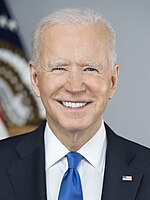
Back ھەڵبژاردنی سەرۆکایەتیی ویلایەتە یەکگرتووەکانی ئەمریکا لە پێنسیلڤانیا (٢٠٢٠) CKB Elecciones presidenciales de Estados Unidos de 2020 en Pensilvania Spanish Élection présidentielle américaine de 2020 en Pennsylvanie French 2020년 미국 대통령 선거 펜실베이니아주 Korean 2020 United States presidential election in Pennsylvania SIMPLE การเลือกตั้งประธานาธิบดีสหรัฐในรัฐเพนซิลเวเนีย พ.ศ. 2563 Thai
| ||||||||||||||||||||||||||
| Turnout | 76.5%[1] | |||||||||||||||||||||||||
|---|---|---|---|---|---|---|---|---|---|---|---|---|---|---|---|---|---|---|---|---|---|---|---|---|---|---|
| ||||||||||||||||||||||||||
| ||||||||||||||||||||||||||
| ||||||||||||||||||||||||||
| Elections in Pennsylvania |
|---|
 |
|
|
The 2020 United States presidential election in Pennsylvania was held on Tuesday, November 3, 2020, as part of the 2020 United States presidential election in which all 50 states plus the District of Columbia participated.[4] Pennsylvania voters chose electors to represent them in the Electoral College via a popular vote, pitting the Republican Party's nominee, President Donald Trump, and running mate Vice President Mike Pence against Democratic Party nominee, former Vice President Joe Biden, and his running mate California Senator Kamala Harris. Pennsylvania had 20 electoral votes in the Electoral College.[5]
Although Trump had won the state in 2016 by a narrow margin of 0.72%, Biden was able to reclaim the state, winning it by a similarly narrow 1.17% margin. Because of the way the state counted in-person ballots first, Trump started with a wide lead on election night. However, over the next few days, Biden greatly closed the margin due to outstanding votes from Democratic-leaning areas, most notably Philadelphia and Pittsburgh, as well as mail-in ballots from all parts of the state which strongly favored him. On the morning of November 6, election-calling organization Decision Desk HQ forecast that Biden had won Pennsylvania's 20 electoral votes, and with them the election.[6] The following morning, November 7, at the same time that the Trump campaign was holding a press conference outside of a Philadelphia landscaping business,[7] nearly all major news organizations followed suit and called Pennsylvania for Biden, proclaiming him president-elect.[8]
One key to Biden's success in the state was his improvement on Hillary Clinton's margins in the large Philadelphia-area suburban counties: he won Bucks by 3.60% more than Clinton did, Delaware by 4.38% more, Montgomery by 4.80% more, and Chester—which Mitt Romney had narrowly won just eight years prior—by 6.60% more. At the same time, he reclaimed two of the three large industrial counties which had voted Democratic for at least six consecutive elections before Trump flipped them in 2016: Erie and Northampton. While Trump prevailed in the third, Luzerne County, he did so by a reduced margin with respect to 2016; and Biden increased the margin of victory in his birth county, Lackawanna County, which Trump had nearly flipped in 2016. Biden halted the four-election Democratic slide in formerly traditionally Democratic Westmoreland County, where, before 2020, Al Gore had been the last Democrat to improve on the previous nominee's vote share (and which had given Trump his margin in the state in 2016). He also improved on Clinton's margins in Lehigh County by 2.9% and won Allegheny County with the largest percentage of the vote since 1988; however, Biden's vote share in Philadelphia County actually declined slightly compared to Clinton's, although he still outperformed either Al Gore in 2000 or John Kerry in 2004 in the county. Biden became the first Democratic candidate running for president to garner at least 100,000 votes in the Republican stronghold county of Lancaster.[9][10] He also became the second presidential candidate since 1964, the last time the county voted for a Democrat, to get at least 40% of the vote.[10] This was due to the large number of votes Biden received from the city of Lancaster and a competitive margin in voting precincts in and around Lititz and Columbia.[11]
Despite Biden's victory, Pennsylvania weighed in for this election as 3.3% more Republican than the national average. This is the second consecutive presidential election in which Pennsylvania voted to the right of the nation. Previously, it had not done so since 1948. With Ohio, Florida, and Iowa backing the losing candidate for the first time since 1960, 1992, and 2000 respectively, this election established Pennsylvania, Wisconsin, and Michigan as the states with the longest bellwether streak still in effect today. The last time any of them voted against the winning candidate was 2004, when all three voted for the losing Democrat John Kerry. Biden became the first Democrat to win the White House without carrying Luzerne County since Harry Truman in 1948. This was the first election since 1932 that the county voted for the statewide loser.
- ^ "Election Stats". Archived from the original on December 9, 2020. Retrieved December 11, 2020.
- ^ "Pennsylvania Election Results 2020". The New York Times. November 3, 2020. Archived from the original on November 4, 2020. Retrieved November 5, 2020.
- ^ "Pennsylvania Elections - Summary Results". electionreturns.pa.gov. Pennsylvania Department of State. Retrieved January 22, 2025.
- ^ Kelly, Ben (August 13, 2018). "US elections key dates: When are the 2018 midterms and the 2020 presidential campaign?". The Independent. Archived from the original on August 2, 2018. Retrieved January 3, 2019.
- ^ "Distribution of Electoral Votes". National Archives and Records Administration. Archived from the original on January 9, 2019. Retrieved January 3, 2019.
- ^ Prokop, Andrew (November 6, 2020). "Why Decision Desk called Pennsylvania, and the presidential race, for Joe Biden". Vox. Archived from the original on November 6, 2020. Retrieved November 7, 2020.
- ^ Cite error: The named reference
FSTL conferencewas invoked but never defined (see the help page). - ^ Stephen Collinson and Maeve Reston (November 7, 2020). "Biden wins Pennsylvania, becoming the 46th president of the United States". CNN. Archived from the original on November 7, 2020. Retrieved November 7, 2020.
- ^ NBC. "Pennsylvania Presidential Election Results 2020". NBC News. Archived from the original on September 8, 2022. Retrieved September 7, 2022.
- ^ a b Leip, Dave. "Dave Leip's Atlas of Presidential Elections". Archived from the original on February 22, 2011. Retrieved September 7, 2022.
- ^ Park, Alice; Smart, Charlie; Taylor, Rumsey; Watkins, Miles (March 30, 2021). "An Extremely Detailed Map of the 2020 Election". New York Times. Archived from the original on February 2, 2021. Retrieved September 7, 2020.





